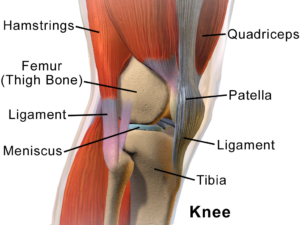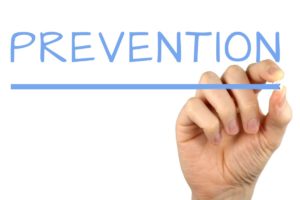Squats are heralded by many as the king of all exercises. Squats blast your legs and recruit the upper back, lower back and core as stabilizers to engage your entire body and spark some serious size and strength gains. However, all of this does not come without its risks. Under great stress, squats can hurt your knees. There are several different possible causes to this pain, but it all stems from the fact that this single joint is supporting loads of up to hundreds of pounds. Combine this stress with the infinite small deviations of perfect form available and you have an environment that is prone to injury and soreness. Before we dive into the direct causes of pain and possible solutions, let’s take a look at the anatomy of the knee.
Anatomy: The Knee
 The knee is a hinge joint (flexion and extension, or up and down) with room for slight twisting. The joint is composed of the knee cap, the femur and the tibia, along with all of the tendons and ligaments that hold them in place and allow for motion and flexibility. There is also cartilage, adipose tissue and bursa in the knee for padding and the minimization of friction. The cartilage can break down with age and activity which is high-impact, and the ligaments can be torn or otherwise injured when the knee moves outside of its safe range of motion. This is why form is important with all leg exercises, as tearing a ligament in your knee can hinder your ability to move, and even walk for months.
The knee is a hinge joint (flexion and extension, or up and down) with room for slight twisting. The joint is composed of the knee cap, the femur and the tibia, along with all of the tendons and ligaments that hold them in place and allow for motion and flexibility. There is also cartilage, adipose tissue and bursa in the knee for padding and the minimization of friction. The cartilage can break down with age and activity which is high-impact, and the ligaments can be torn or otherwise injured when the knee moves outside of its safe range of motion. This is why form is important with all leg exercises, as tearing a ligament in your knee can hinder your ability to move, and even walk for months.
Causes of Knee Pain During Squats
Knee pain during squats aren’t isolated to one movement or one condition, unfortunately. Take a look at these common causes and see which applies to you:
Shearing Force
Shearing force tears up your knees, plain and simple. Shearing force happens upon the contraction of your quadriceps with no accompanying co-contraction – this causes the patella (knee cap) to be pulled back and away from the tibia, which places a ton of stress on your ACL (you know, that thing that football players tear and they’re out for the rest of the season). Shearing force is present in quadriceps isolation exercises, namely the leg extension and if you have bad knees, you should be staying as far from these movements as possible. If you have no history of knee pain, feel free to partake sparingly, but if you’re doing these several times a week it can spell disaster for your knees’ long-term health.
Performing leg extensions often will stress your ACL and carry over into your squats, giving you pain at the bottom of the movement, and possible residual pain after the exercise is complete, depending on how bad your knees have become. If you include leg extensions in your leg workouts and find that you have knee pain when squatting, that could very well be the culprit.
Stance
The way you stand greatly affects how your knees perform under tension, specifically with squats. If you squat with your feet too far apart or too close together, you’re placing extra strain on your cartilage and ligaments, and messing with your patellar tracking. If your knees are falling in when you squat, de-load and work on form and foam rolling your IT band, as caved in knees during a squat are a very, very quick road to permanent injury and pain.
Wrong Shoes
As my friend Austin Matthews once told me, “Your 4 year-old Nike’s are great for trips to the grocery store or mowing the lawn, but they suck for squatting.” Austin is a certified personal trainer and resident health and fitness expert for the website ProductAdvisor.com – and he makes an extremely good point. Shoes without a solid heel cup or arch support can cause your feet to rock from side to side or roll in when you’re squatting, which can cause uneven weight distribution and weight transfer through your knees. Moving straight up and down in the squat is ideal, and if you’re constantly adjusting your balance due to beat up shoes, you’re tearing up your knees. Those little micro-adjustments add up and the lateral movement combined with a vertical load places a lot of stress on the knee joint.
Lack of Mobility
Stiff knees are knees prone to injury. Jumping straight into a working set without warming up can place your ligaments at serious risk, especially if you have stiffness in your knees throughout the day. Cold ligaments aren’t primed and ready for movement, and are much more affected by stress. Think of how cold taffy and warm taffy react to stressors – this is a pretty decent comparison to the ligaments in your knee.
Preventing Future Pain

Luckily, there are several measure you can take to prevent knee pain from occurring in the future and ease the pain you’re currently experiencing, if any. Take note of these preventative measures, as they could save you a few trips to the doctor down the road.
Stance Correction
As we talked about earlier, stance can be a huge cause of knee pain during the squat. Remember, keep your feet shoulder width apart and keep your toes pointed slightly outward. This stance maximizes the contraction of your quadriceps and decreases the load on your knees.
Knee Wraps
There are two reasons for wearing knee wraps: 1) You’re squatting heavy (85%-100% of your 1RM) and 2) Your knees are so bad that you could not squat without supplemental support.
Most, if not all competitive powerlifters wear knee wraps when squatting heavy. The take some stress off of the lower quadriceps and make the movement easier on your knee joints; however, if you don’t have knee problems and you’re squatting for 6+ reps, the wraps will take over and you won’t get much out of your workout. Also, if you have bad knees and can’t take the stress of an unwrapped squat, feel free to wrap up for them, as they can be a great way to get under the bar when otherwise unable.
A Sturdy Pair of Shoes
There are several pairs of lifting shoes on the market especially for supporting your body when you work out; however, these can be costly. A simple pair of Converse All Star’s will do the trick if you don’t feel like doing the research. Basically, look for shoes with a hard sole that are lightweight and allow your foot to be level – no elevated heels.
Final Thoughts
If you are at all able to squat, you should be squatting. Squats are a fantastic compound exercise with several benefits, along with being a natural, functional movement. Squatting with heavy loads in the wrong way, or with the wrong equipment can lead to injury and knee pain, but there are some simple fixes you can do to prevent future pain and dial down any existing knee pain. Now get under the bar, keep that form strict and get to squatting.
Leave a Reply